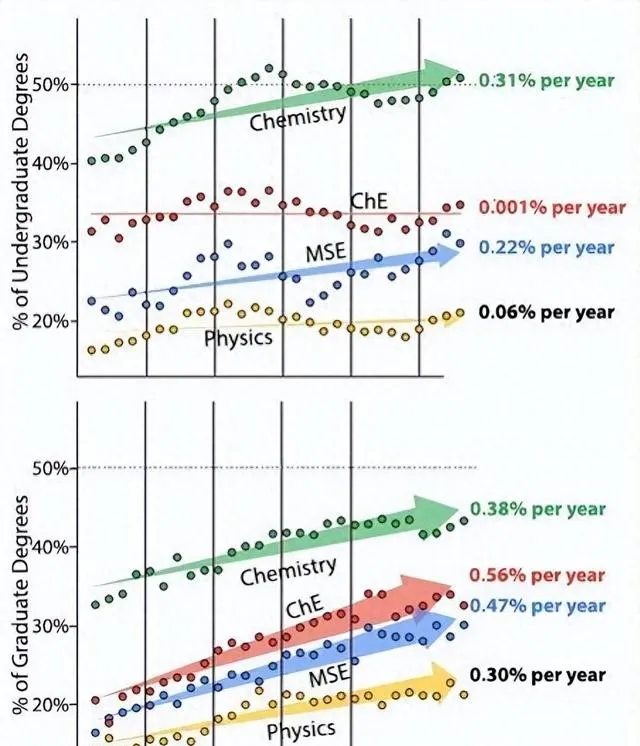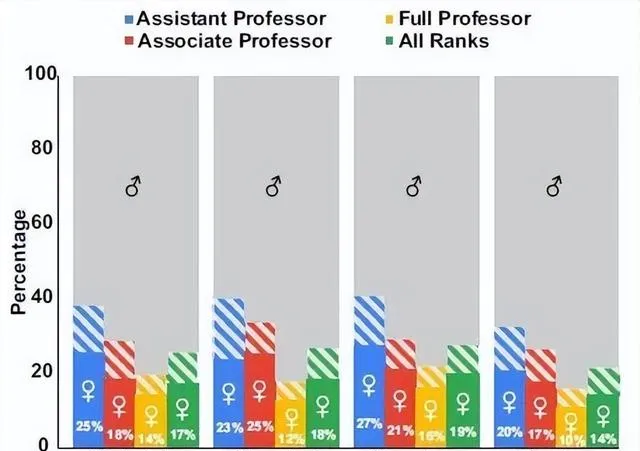在近代歷史上,人們對性別平等的態度有了相當大的改善。然而,由於職業發展、對女性的認識和認知等方面仍存在系統性偏見,不平等在許多領域仍然存在,這也包括計算材料研究子領域。解決公平方面的問題符合所有人的利益。針對科學研究,包容性是至關重要的,這不僅是從倫理的角度來看,而且對於吸引和留住敬業和有才華的頭腦、增強領域的活力、培養各種各樣的思維都是如此。
代表和思維的多樣性可以提高一個人類的集體智慧,提高生產力,並提高我們計算材料研究者在該領域得持續性。此外,代表全體民眾對於確保科學對社會需求負責和相關也是必要的。

Fig. 1 Trends in the percentage of undergraduate and graduate degrees awarded to women in the United States of America, National Center for Education Statistics5.
Arrow widths are proportional to the rate of increase. Trendlines were determined through regularized linear regression.
來自英國華威大學化學系的Livia B. Pártay等,透過對文獻數據的參照和分析,回顧了當前女性在科學領域面臨的挑戰和障礙。根據美國教育統計中心報告,特別是美國學術機構按學科和性別頒發的學位數量,在過去30年裏,授予女性研究生學位的比例在所有領域都得到穩步上升,但科學、技術、工程和數學(STEM)學科的男女本科生之間的差距仍然很大。

Fig. 2 Percentages of female faculty across ranks, as reported by the Academic Analytics Research Center .
Striped bars indicate faculty of unknown gender. Here we use the American- style professorial ranks, where an 「assistant」 professor refers to a pre-tenure junior professor, an 「associate」 professor refers to a post-tenure mid-level professor, and a 「full」 professor refers to a senior-level tenured professo r.
造成女性在STEM環境中面臨的障礙通常可以總結為:無意識偏見,關於女性適合這個領域的刻板印象;居禮夫人策略,被認為是女性成功所必需的特殊人格特質;關懷的責任,期望女性承擔照顧孩子的主要負擔;知名度低,排斥女科學家,缺乏傑出的榜樣。這些偏差和障礙可以透過一系列不同的測量方式表現出來:從認知方面來說,論文參照率低、推薦信短、較低的資金、獎項不平等、學生評價;從工作環境來說,較少的交際機會、不成比例的工作量。
Fig. 3 A Summary of gender inequity causes, manifestations, and responses.
Many of these phenomena are interrelated, and it is important to take a multi-pronged approach to addressing the causes and manifestations of these inequities. Individual images obtained through the Noun Project (thenounproject.com).
解決障礙最重要的就是承認偏見的存在,然後采取實際行動,如無意識偏見辨識和解決社會刻板印象的培訓;改變檢查性別偏見的敘述,向不同的學生群體展示和宣傳研究目標;增加知名度和指導,以鼓勵歸屬感和專業信心;透過在體制政策和非正式互動中灌輸包容性來改善環境;改革資金和獎勵制度,以提高透明度,並將成就衡量標準擴大到出版物之外;透過參照多樣性聲明和其他工具檢查引文和推薦中的性別偏見。
本篇論文對計算材料研究領域中的性別不平等進行了總結,希望可以提高科學界的認識,並推動學術界走向更公平的環境。該文近期釋出於 npj Computational Materials 9: 98 (2023)。

Fig. 4 Usage of artificial intelligence. Would you use an AI tool to create graphics for your presentation or visual communications?
Four computational materials scientists having a research discussion, as imagined by the AI tool images.ai, only depicts older white men.
Editorial Summary
The unequal treatment faced by women in computational materials researchWhile attitudes on gender equity and parity have considerably improved in recent history, there are still measurable inequities stemming from systemic bias in the career progression, recognition, and perception of women in the sciences, including our sub-field of computational materials research.
Addressing the obstacles to equity is in everyone’s interest. Making research inclusive is critical, not only from an ethical standpoint, but also for attracting and retaining dedicated and talented minds, enhancing the vibrancy of all fields, and nurturing a diverse range of ideas.
Diversity in representation and thought can increase a group’s collective intelligence, improve productivity, and improve retention in growing fields such as ours. Representation of the entire populace is also necessary for ensuring that science is responsible and relevant to societal needs.
In a perspective, Livia B. Pártay et al . from the Department of Chemistry at the University of Warwick, UK, reviewed the current challenges and barriers for women in science, citing data and analysis from the literature. Based on the number of degrees awarded by subject and gender by US academic institutions reported by the US Department of Education National Center for Education Statistics (NCES), the authors demonstrated that the proportion of graduate degrees awarded to women has steadily increased in all fields over the past 30 years, but the gap between male and female undergraduates in science, technology, engineering, and mathematics (STEM) disciplines often still looms large.
The barriers that women face in STEM environments can often be summed up as: Unconscious biases- stereotypes about women’s fitness for the field, the Marie Curie Strategy-special personality traits deemed necessary for a woman’s success, Caring Responsibilities-expectation that woman assume the primary burden of caretaking, Decreased Visibility-exclusion of woman scientists and lack of prominent role models.
These biases and barriers can be measured in a range of different ways, from a cognitive perspective, such as low citation rates, short letters of recommendation, lower funding, award inequality, gendered student evaluations, in terms of the working environment, decreased networking opportunities, disproportionate workload.
The first step in addressing the barriers is to acknowledge the existence of bias and then take practical action, such as unconscious bias training to identify and address social stereotypes, changing the narrative to show and advertise the goals of research to diverse student populations, improving visibility and mentoring to encourage belonging and professional confidence, improving environments by installing inclusiveness in institutional policies and informal interactions, reforming funding and awards to increase transparency and broaden accomplishment metrics beyond publications, checking gender-bias in citations and recommendations through Citation Diversity Statement (CDS) and other tools.
This paper summarizes the gender inequality in the field of computational materials research, hoping to raise awareness in the scientific community and move academia towards a more equitable environment. This article was recently published in npj Computational Materials 9 , 98 (2023).
原文文題、作者
Not yet defect-free: the current landscape for women in computational materials research (尚不完美:計算材料研究中女性的現狀)Livia B. Pártay, Erin G. Teich & Rose K. Cersonsky











